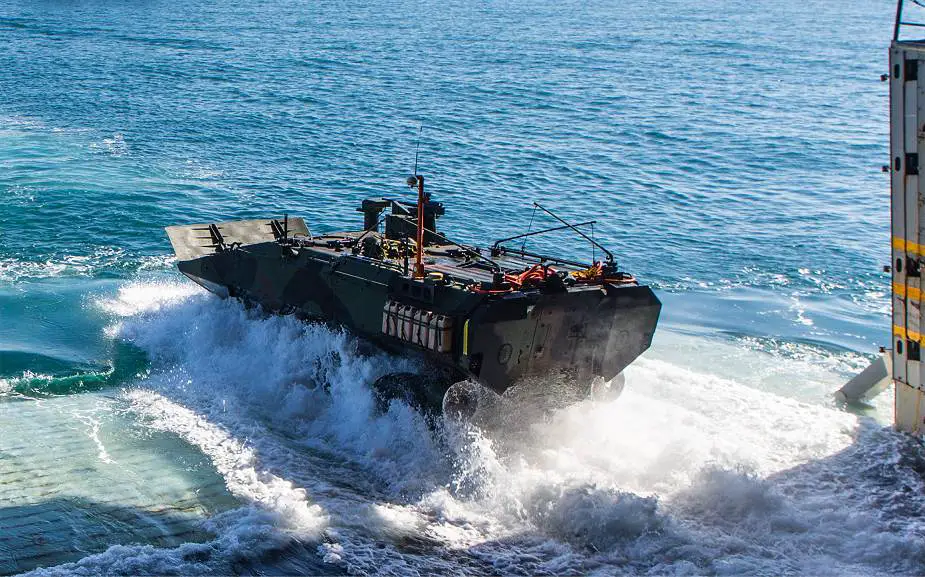Having received the first 18 ACVs manufactured by BAE Systems in low-production rate, the first unit of the U.S. Marine Corps is now operational with the Corps’ new Amphibious Combat Vehicle. BAE Systems is now ready for full-rate production with IVECO’s support.
Follow Army Recognition on Google News at this link

ACV during testing by the U.S. Marine Corps (Picture source: USMC)
Iveco Defence Vehicles’ experience in developing wheeled armored platforms dates to the 1930s, when the plant of this Italian company in Bolzano was established. Lancia and later Iveco have developed several 4x4 armored vehicle for the domestic market, the Italian Army, but the main experience comes from the development of the Centauro 8x8 armored fighting vehicle in the ‘90s.
For USMC’s ACV program in 2011, IVECO initially supplied one kit of the SUPERAV (Iveco’s 8x8 AmpibiousVehicle based on the Centauro Family of Vehicles) to BAE Systems in view of participating in the tender. BAE Systems then welded, assembled and fitted all its own components/susbsystems leading to the final vehicles submitted to the U.S. Marine Corps. Hence, the ACV became a US-led program.
The IVECO Centauro Armored Fighting Vehicle, which aimed to replace MBTs with a high-speed Armored Fighting Vehicle, equipped with a high pressure 105mm cannon able to fire throughout 360 degrees while moving, required a stable and powerful platform. The result was a well-performing armored vehicle, with a unique H-shaped transmission that enabled a much lower profile with respect to any other 8x8 or 6x6 armored vehicle in the world.
The experience matured with the Centauro family, adopted by Italy, Spain and Oman, developed across several models and adapted to the continuous changes in the operational environment, played a key role when the Company decided to approach the amphibious operations environment. The engineering team decided to develop an amphibious armored vehicle based on the 8x8, H-transmission adopted by the Centauro family, implementing them in a new hull concept, able to balance mobility requirements on water and land. Our unique H-shaped transmission demonstrated paramount advantages, enabling the adoption of effective protection solutions against mines, IEDs and ballistic threats.
This design, coupled with BAE Systems’ elements, matched the requirements of the US Marine Corps, that was looking for a new amphibious combat vehicle (ACV) able to perform in the modern land environment after a ship to shore trip. Knowing that each single pound dedicated to additional protection was obviously ballast for the navigation mission, a complex challenge to fulfill those demanding requirements was set. After years of intensive work, we are honored to say that we overcame the challenge, in cooperation with an outstanding partner in BAE Systems.
June 2018 is considered in Iveco’s Bolzano Headquarter as the U.S. success month. For nearly a decade IVECO has invested in the ACV program working on it with enthusiasm and dedication, providing platform design and core components to its partner BAE Systems. IVECO is greatly satisfied with the contract being awarded and is significant recognition. The Italian manufacturer demonstrated to the world how it can satisfy the most demanding customer, by developing a vehicle capable of fast fording in choppy seas, landing safely, travelling across varied terrain and can achieve speeds of over 50 miles per hour, perform combat missions and effectively protect the crew. The new ACV FOV (Family Of Vehicles) represents the optimum balance of sea and land mobility, survivability, and future growth potential.
On Oct. 15, 2020, IVECO announced the program led by BAE Systems had reached a new paramount milestone within the ACV program. After five years of extensive testing development and consultation with USMC, the first fleet of 18 ACVs has been delivered to a platoon of Marines. IVECO is now looking forward to initiating full rate production and to supporting the fielding of the next units in early 2021.














